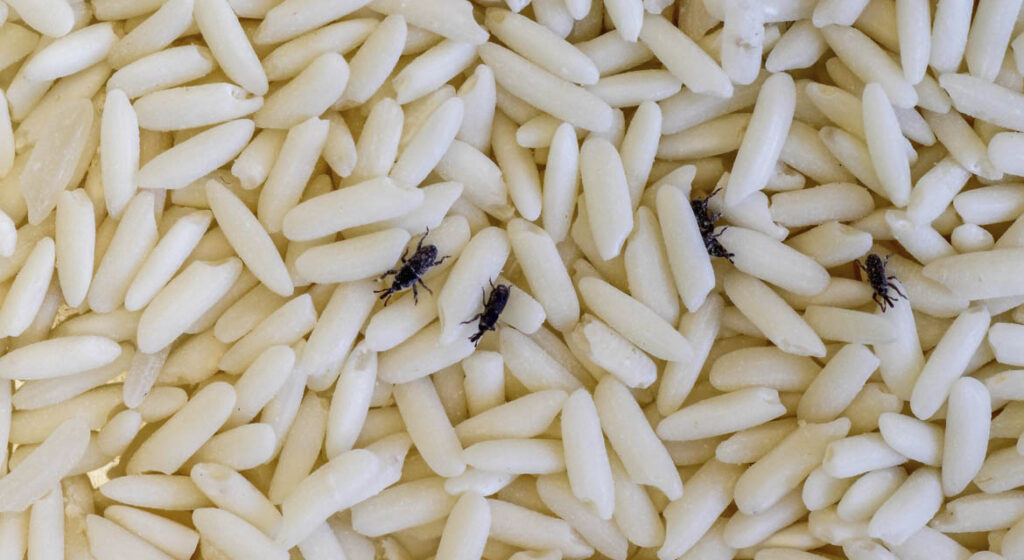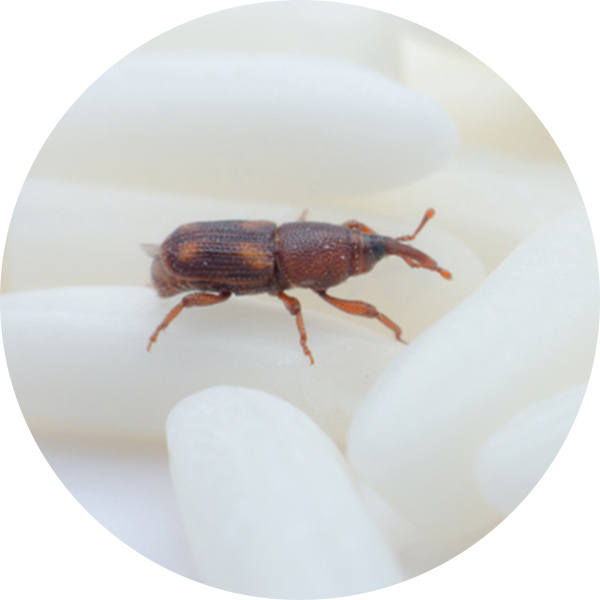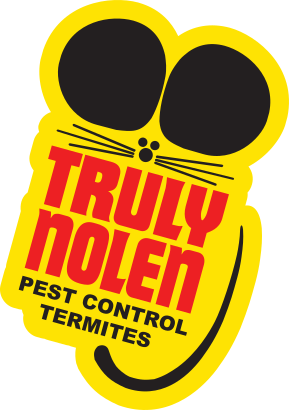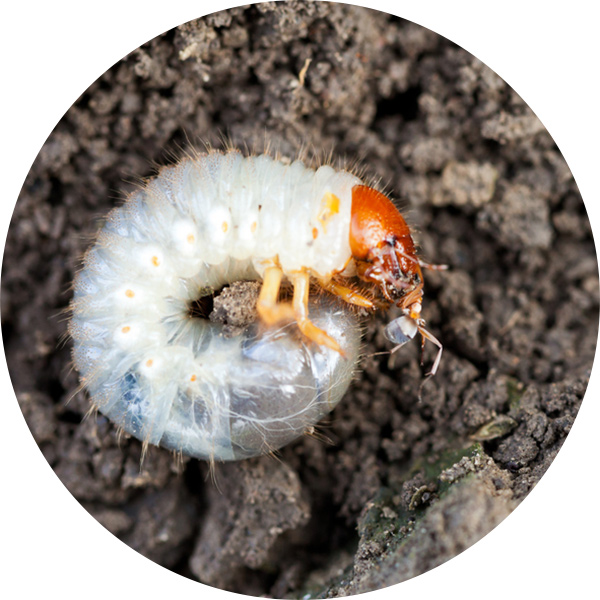
Weevil Facts & Information
A weevil infestation at home raises concerns about damage to stored food items, potential contamination, and the difficulty in eradicating the infestation completely.
Risks of Weevils
Food Contamination
Weevils are pests that infest stored food products, particularly grains, cereals, rice, flour, pasta, and other pantry staples. The presence of weevils in food can result in contamination, rendering the food unsuitable for consumption. Weevils lay eggs in the food, and when the eggs hatch, the larvae feed on the food, causing damage and leaving behind frass (insect waste) and webbing. Consuming infested food can lead to health concerns or foodborne illnesses.

Financial Losses
Weevil infestations can lead to significant financial losses, particularly for commercial food establishments or agricultural operations. Infestations in storage facilities or warehouses can result in damage to large quantities of stored grains or other food commodities. Contaminated food may need to be discarded, leading to financial losses and potential damage to a business’s reputation.
Pest Management Challenges
Weevils are persistent pests that can be challenging to control. They have the ability to hide in small crevices, packaging materials, or equipment, making it difficult to completely eliminate their presence. Weevils can also develop resistance to certain pesticides over time, further complicating control efforts. Effective management of weevil infestations often requires a combination of strategies, including proper sanitation, inspection, monitoring, and the use of targeted insecticides.

Truly Nolen GUARANTEE
If you’re not completely satisfied, you’ll get a full refund on your most recent service with our 100% money back guarantee.
Common Species of Weevils

Rice Weevil

Granary Weevil

Boll Weevil
How To Identify Weevils
Weevils are small beetles with elongated snouts and are typically dark-colored or reddish-brown; to identify a weevil infestation at home, look for adult weevils or their larvae in stored food items such as grains, rice, flour, or pet food, along with the presence of holes, webbing, or a foul odor indicating their feeding and breeding activity.
Weevil Appearance
Weevils are small beetles characterized by their elongated snouts or rostrums. They range in size from 2 to 10 millimeters in length. Weevils have a hard exoskeleton, distinct body shapes, and often exhibit various colors and patterns, including mottled patterns or solid colors.
Weevil Habitat
Weevils are found worldwide and inhabit a wide range of habitats, including forests, fields, gardens, and stored grain facilities. They can adapt to diverse environments and are commonly associated with plants and plant-based materials.
Weevil Diet
Weevils are herbivores and primarily feed on plant materials. They have specialized mouthparts that allow them to chew or pierce through plant tissues. Weevils are known for infesting grains, seeds, nuts, fruits, and various stored products, causing significant damage.
Weevil Behavior
Weevils are known for their ability to damage crops and stored food products. They are adept at locating suitable food sources, often by sensing chemical cues emitted by plants. Weevils can chew through plant tissues, creating holes or tunnels. Some species also have the ability to fly, while others are flightless.
Weevil Reproduction
Weevils undergo complete metamorphosis, consisting of four life stages: egg, larva, pupa, and adult. Female weevils typically lay eggs directly into plant tissues or stored products. After hatching, the larvae feed and develop within the host material, often causing the most damage. Larvae then pupate and eventually emerge as adults, ready to reproduce and continue the life cycle.
Weevil Prevention
Preventing and controlling weevils involves implementing integrated pest management strategies. Proper storage and handling of susceptible products, such as grains and stored food items, is crucial to minimize infestations. Practices include maintaining cleanliness and hygiene, using airtight containers, regularly inspecting stored goods, and rotating stock to prevent long-term storage. In agricultural settings, crop rotation, pest-resistant varieties, and timely harvest can help manage weevil populations. Chemical control methods, such as insecticides, can be used in severe infestations but should be applied judiciously and following label instructions.

$50 Off Year Round Pest Control
Truly Nolen is a family-owned company with 85 years of experience providing the best pest control. If you’re not completely satisfied, you’ll get a full refund on your most recent service with our 100% money back guarantee.
The Truly Nolen Approach
Environmentally Conscious
We work to minimize our impact on the environment by using naturally occurring materials whenever possible.
Pet Friendly
Truly Nolen uses an Integrated Pest Management (IPM) approach designed with your pets in mind.
100% Money Back Guarantee
If you’re not completely satisfied, you’ll receive a full refund on your most recent service.
How Truly Nolen Gets Rid of Weevils
Truly Nolen is a pest control company that offers comprehensive treatment for weevil infestations. The process typically involves the following steps:
Inspection: A trained technician will conduct a thorough inspection of your property to identify the extent of the weevil infestation, locate their breeding sites, and assess any conditions that may be contributing to the problem.
Identification and Assessment: The technician will identify the specific species of weevils present and determine the level of infestation, allowing for a targeted treatment approach.
Customized Treatment Plan: Based on the assessment, a customized treatment plan will be developed, taking into account the severity of the infestation, the location of breeding sites, and any specific requirements of the property.
Treatment Application: The technician will apply appropriate treatment methods, which may include the use of insecticides, insect growth regulators, or other control measures to target the weevils at all life stages, including eggs, larvae, and adults. The treatment may involve both interior and exterior areas, focusing on infested areas and potential entry points.
Monitoring and Follow-up: After the initial treatment, ongoing monitoring will be conducted to assess the effectiveness of the treatment and identify any residual weevil activity. Follow-up treatments may be necessary to ensure complete eradication and prevent future infestations.
Preventive Measures and Recommendations: Truly Nolen may provide recommendations on preventive measures to reduce the risk of future weevil infestations, such as proper food storage practices, sealing entry points, and maintaining cleanliness in susceptible areas.
It’s important to note that the specific process may vary depending on the severity of the infestation, the type of property, and other factors. Consulting with a Truly Nolen professional will provide you with accurate and detailed information tailored to your specific situation.
Frequently Asked Questions
How do weevils get into my home and infest stored food?
Weevils can enter homes through infested food products purchased from stores, as they often lay eggs on grains, rice, flour, and other food items. Once inside, they can multiply quickly and infest nearby stored foods.
Are weevils harmful to human health?
Weevils themselves are not directly harmful to human health, as they do not bite or spread diseases. However, consuming food infested with weevil larvae or their eggs is generally considered unappetizing and may cause digestive discomfort. Learn More!
How can I prevent weevil infestations in my kitchen and pantry?
To prevent weevil infestations, store food items in airtight containers, regularly inspect and clean your pantry, rotate food supplies, freeze susceptible items for a few days to kill any eggs or larvae, and check for signs of infestation before purchasing packaged foods.
How do I get rid of weevils in my kitchen and pantry?
To eliminate weevils, remove infested food products, thoroughly clean shelves, vacuum cracks and crevices, use insecticidal sprays or traps specifically designed for weevils, and consider professional pest control services for severe or persistent infestations. Learn More!
Can weevils infest other areas of the house besides the kitchen?
While weevils are commonly found in kitchen and pantry areas due to food sources, they can potentially infest other areas where suitable conditions exist, such as storage areas, garages, or even pet food storage. It’s important to be vigilant and take preventive measures throughout the house.

